Cloud Identity and Access Management (IAM) is the cornerstone of contemporary cloud security, governing authorized access to resources while streamlining identity and permission management across various cloud platforms. IAM plays a pivotal role in establishing robust security foundations, highlighting the significance of access management solutions and identity as the primary security parameter in our evolving digital landscape. In an age of digital transformation, mastering Cloud IAM is imperative for safeguarding data and upholding trust within our interconnected world.

What Is Cloud Identity and Access Management (IAM)?
Cloud Identity and Access Management (IAM) is a fundamental aspect of contemporary cybersecurity tailored for cloud-based environments. Essentially, Cloud IAM encompasses a suite of practices, policies, and technological tools devised to regulate and oversee user access to a diverse range of cloud resources, including data, applications, and services. It acts as a digital gatekeeper, ensuring that only authorized entities and systems gain entry to sensitive information and functionalities within the cloud infrastructure. A crucial component of Cloud IAM is the cloud identity management system, which provides the foundation for user identity management, handling authentication, authorization, and permissions across multiple cloud platforms. This dual function not only enhances security measures but also simplifies administrative tasks, empowering organizations to maintain vigilant control over their digital assets while fostering secure and seamless collaboration across cloud ecosystems.
In essence, Cloud Identity and Access Management (IAM) marks a paradigm shift from securing physical boundaries to safeguarding digital identities. It acknowledges that in an era where data is stored and accessed from diverse locations and devices, the traditional network perimeters have become insufficient. Instead, it underscores the significance of overseeing and securing user identities along with their associated privileges. Cloud IAM solutions feature elements such as multi-factor authentication, role-based access control, and comprehensive audit trails to ensure that the right individuals possess the appropriate level of access to cloud resources. By embracing Cloud IAM, organizations can fortify their security posture, adapt to the dynamic landscape of cloud computing, and uphold stringent data protection and compliance standards in an increasingly digital-centric world.
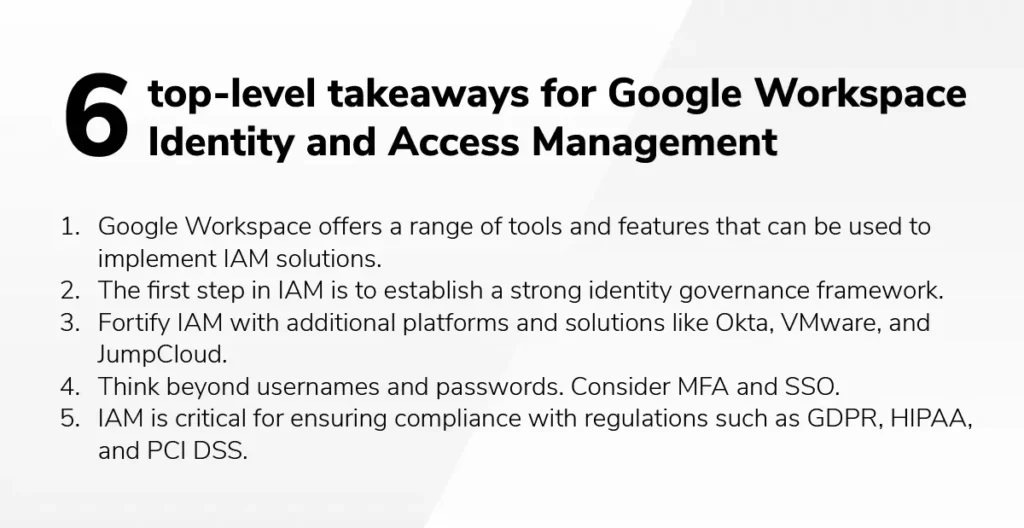
6 top-level takeaways for Google Workspace identity and access management
The desire to boost productivity and collaboration for hybrid, distributed teams has naturally led many enterprises to Google Workspace. While this popular, cloud-native set of tools has allowed teams to work together seamlessly in any configuration, its Identity and Access Management (IAM) features provide assurance that data and users are protected at every level.
SADA provides support for organizations of any size and in any industry to get the most from Google Workspace and third-party IAM solutions, from seamless migrations to ongoing managed services. In this blog post, we’ll share insights into how your organization can protect your system and users with a robust IAM strategy that includes Workspace, third-party solutions, and ongoing managed services from SADA. Consider this your primer on everything IAM can offer your business, and the sorts of considerations you’ll need to make when establishing a strong IAM strategy.
1. IAM, integral to Google Workspace
Simply put, IAM refers to the set of policies, procedures, and technologies that organizations use to control access to their systems, applications, and data. IAM is a critical component of any organization’s cybersecurity strategy because it helps ensure that only authorized personnel can access sensitive information.
As more organizations operate in the cloud, IAM becomes increasingly vital. We’ve found that Google Workspace provides a powerful platform for implementing IAM solutions.
Google Workspace has a number of tools and features that can be leveraged for the implementation of IAM solutions.Google Workspace excels in delivering a seamless single sign-on (SSO) experience as one of its prominent features. SSO enables users to sign on once and access all of the apps and services they need without having to re-enter their credentials. This simplifies the user experience and assists organizations in verifying that users are both authenticated and authorized to access certain applications and services.
Google Workspace also provides other IAM-related functionalities such as role-based access control (RBAC) and multi-factor authentication (MFA). Administrators possess complete control in determining access to resources and the associated conditions. RBAC empowers organizations to specify roles with corresponding permissions, and MFA enhances security, requiring that users provide additional authentication factors, like a one-time code sent to their mobile device.
2. Set your foundation with identity governance
The first step in IAM is to establish a strong identity governance framework. Identity governance is a process that involves defining and managing user roles and permissions in an organization, creating policies around granting and revoking access, and monitoring access to make sure organizations are complying with regulations.
We’ve observed that many enterprises depend on Google Cloud Identity Premium, which provides robust core identity and endpoint management services, enterprise security, application management, and device management services. What’s more, these services include features such as automated user provisioning, app whitelisting, and automated mobile device management. For those who are serious about IAM, Google Cloud Identity Premium is a great place to start.
3. Fortify IAM with additional platforms and solutions
In addition to features native to Google Workspace and Google Cloud Platform, we’ve found a number of third-party solutions that augment, compliment, and extend IAM. Here are a few solutions that enterprises have increasingly come to rely upon:
- Okta: Cloud-based software that helps organizations manage and secure user authentication in applications, and for developers to build identity controls into applications, website web services, and devices.
- VMware: A solution enabling secure role-based access control, password management, and account policies. VMware Workspace One extends these capabilities to devices.
- JumpCloud: An open directory platform that allows organizations to centrally manage one identity and one set of credentials per user, with unified and automated identity creation and deactivation, as well as access provisioning and deprovisioning.
- Google BeyondCorp Enterprise (BCE): A solution that provides simple and secure access to applications and cloud resources with a zero trust focus.
- Prisma Cloud IAM Security: A solution for evaluating effective permissions assigned to users, workloads, and data so that organizations can properly administer IAM policies and enforce access using the principle of least privilege.
Every business is different, operating in a variety of regulatory environments with industry-specific needs. Finding the right third-party platforms and software to augment your IAM solution may be daunting. That’s where SADA comes in. With a track record of successful deployments, your dedicated SADA team will work side by side with your team to develop the strategy that’s just right for you. Industry best practices, unique regulatory requirements, and your organization’s desired business outcomes are all part of the conversation.
4. Think beyond usernames and passwords
Traditionally, IAM has been focused on managing usernames and passwords. However, modern IAM solutions are much more sophisticated and can include Okta, JumpCloud, Google Cloud Identity Premium, and other security measures that take into account evolving workplaces and increased device usage.
MFA, a robust security mechanism that requires users to provide two or more forms of authentication to access a certain resource, is a highly effective method to protect against password-based cyber attacks. More and more enterprises are leveraging MFA, prompting users to input a password alongside additional factors like fingerprints or smart cards for enhanced security.
SSO, facilitating access to multiple resources using a single set of credentials, stands as a vital component of contemporary IAM. It streamlines user authentication, diminishing the likelihood of credential theft.
You’ll also want to consider Google Cloud Identity-Aware Proxy, which provides a secure method for accessing applications and services hosted on Google Cloud Platform. It supports MFA and SSO, and enables administrators to control access to resources based on user and device attributes.
5. Ensure regulatory compliance with IAM
IAM is critical for ensuring compliance with regulations such as GDPR, HIPAA, and PCI DSS. These regulations require organizations to implement controls around data access and security, and IAM is a key part of those controls.
As an illustration, GDPR mandates organizations to adopt suitable technical and organizational measures to secure personal data, encompassing controls like role-based access control (RBAC) and multi-factor authentication (MFA) to regulate data access.
Google Workspace provides a variety of IAM tools designed to be the backbone of compliance. For example, Google Cloud IAM enables administrators to define custom roles and permissions that can be used to control access to resources. It also provides audit logs that can be used to monitor access and compliance.
6. Think of IAM as a continuous process
It’s important to understand that IAM depends on vigilance. It’s not something that can be implemented once and then forgotten about. Your organization is wise to continually monitor and update your IAM policies and procedures to ensure that they remain effective. But this can be a heavy lift, especially when you wish to direct your teams to other business-critical projects.
That’s where your dedicated SADA team comes in. Informed by countless successful deployments of IAM solutions, including enterprise-level Workspace migrations and the implementation of powerful third-party solutions, SADA experts will listen to your ambitions, help you implement cost-efficient solutions, and bring your teams on board with a host of change management and training resources. To learn more about the IAM and Google Workspace solutions that are right for your business, be sure to take a look at our productivity and collaboration resources today.
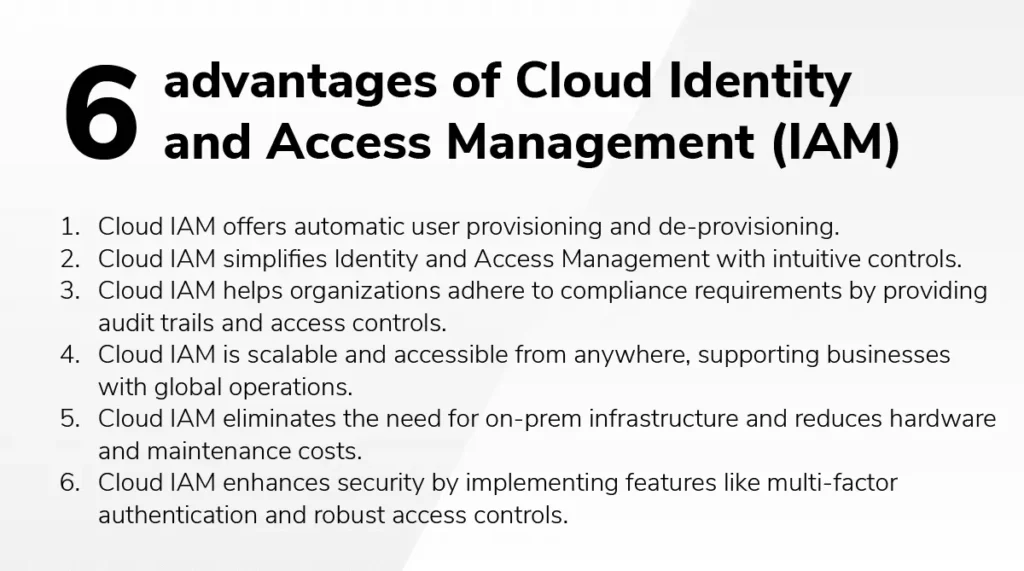
6 advantages of Cloud Identity and Access Management (IAM)
Cloud Identity and Access Management (IAM), often referred to as cloud-based identity, offers a multitude of benefits for organizations navigating the complexities of the digital landscape. From enhancing security to simplifying access control, Cloud IAM provides a robust framework that ensures efficient and secure management of user identities and permissions. In this era of cloud computing, understanding the advantages it brings is essential for organizations striving to protect their data and optimize their operations.
1. Automatic
Cloud IAM offers automatic user provisioning and de-provisioning, reducing administrative burdens. Users gain access to resources as needed and lose access when they no longer require it, enhancing efficiency and security.
2. Straightforward
Cloud IAM simplifies identity and access management with intuitive controls. It’s user-friendly, making it easier for organizations to manage access permissions and maintain security protocols.
3. Compliant
Cloud IAM helps organizations adhere to compliance requirements by providing audit trails and access controls. This ensures that sensitive data is handled in line with regulatory standards.
4. Global
Cloud IAM is scalable and accessible from anywhere, supporting businesses with global operations. It allows consistent identity management across diverse geographical locations.
5. Less expensive
Cloud IAM eliminates the need for on-premises infrastructure and reduces hardware and maintenance costs. It offers a cost-effective solution for managing identities and access.
6. Safer
Cloud IAM enhances security by implementing features like multi-factor authentication and robust access controls. It safeguards against unauthorized access, data breaches, and cyber threats.
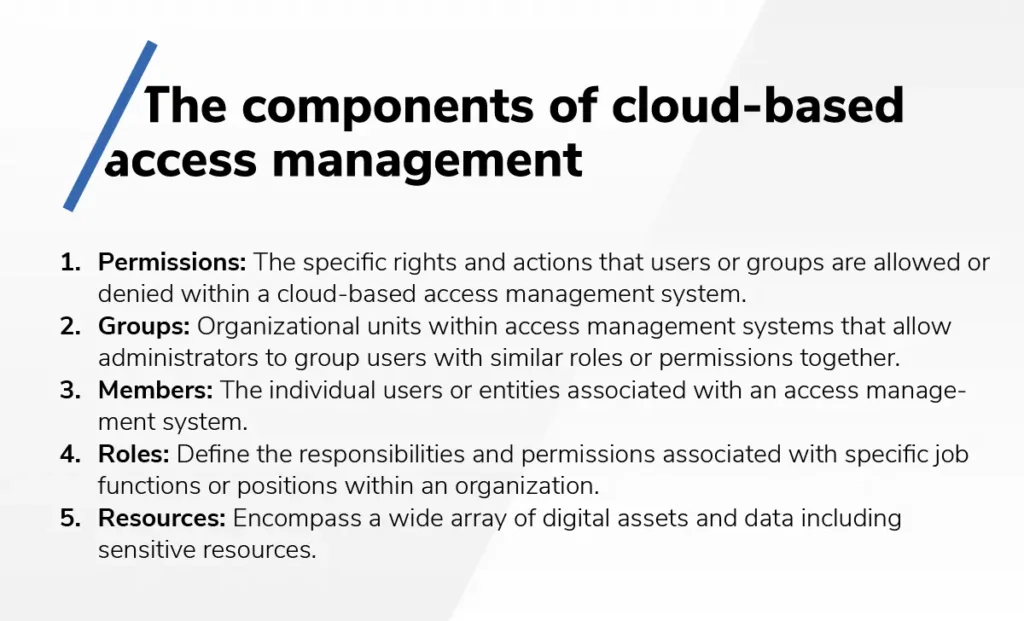
What are the components of cloud-based access management?
Cloud-based access management comprises several key components that collectively ensure secure and controlled access to digital resources in cloud environments. These components include:
Permissions
Permissions refer to the specific rights and actions that users or groups are allowed or denied within a cloud-based access management system. They determine what individuals or entities can do with particular resources or data.
Groups
Groups are organizational units within access management systems that allow administrators to group users with similar roles or permissions together. Managing access for multiple users becomes more efficient when they are assigned to groups with predefined permissions.
Members
Members are the individual users or entities associated with an access management system. Each member has specific roles and permissions that dictate their level of access to resources within the cloud environment.
Roles
Roles define the responsibilities and permissions associated with specific job functions or positions within an organization. They determine what actions users can perform, such as read, write, or delete, and are assigned to members to grant appropriate access.
Resources
Resources in the context of cloud computing encompass a wide array of digital assets and data including sensitive resources. These may comprise files, databases, applications, or any other elements that users require access to or interaction with. The primary objective of access management is to safeguard these sensitive resources, ensuring that they remain accessible solely to authorized users or designated groups while maintaining security protocols.
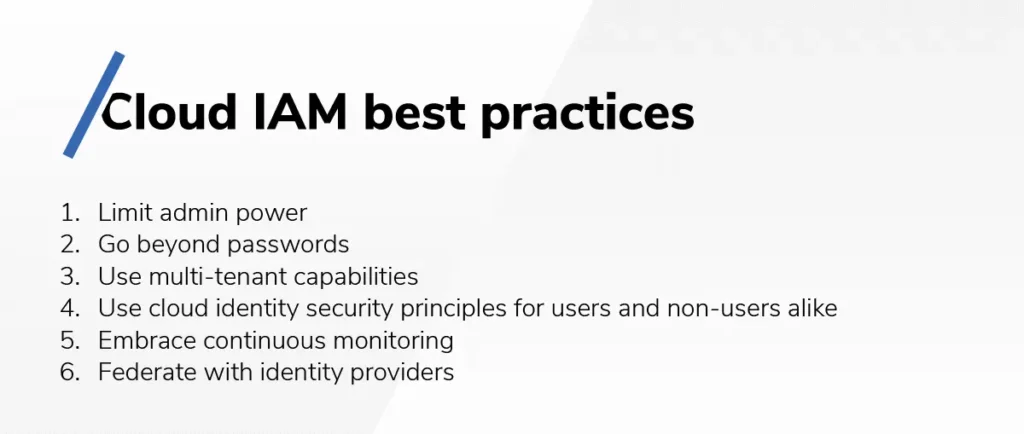
Cloud IAM best practices
Cloud IAM best practices are vital for cloud security. They include limiting admin access, using advanced authentication, multi-tenancy, securing non-users, continuous monitoring, and federating with trusted identity providers to enhance overall security and efficiency in the cloud.
Limit admin power
Limiting administrative privileges is a fundamental Cloud IAM best practice. It involves granting administrators only the minimum level of access needed to perform their tasks. This practice reduces the risk of unauthorized or accidental actions that could compromise security.
Go beyond passwords
Incorporating advanced authentication methods beyond traditional passwords is crucial. This includes techniques like multi-factor authentication (MFA), biometrics, and smart cards. These additional layers of security help protect against unauthorized access, especially in a cloud environment.
Use multi-tenant capabilities
Leveraging multi-tenant capabilities allows organizations to efficiently manage multiple customer or business units within a single Cloud IAM instance. It ensures scalability, resource isolation, and streamlined administration, making it easier to meet diverse access management needs.
Use cloud identity security principles for users and non-users alike
Cloud IAM best practices extend beyond just managing user access. They also apply to non-user entities like applications and services. Implementing robust identity and access controls for these entities is crucial to maintain comprehensive security, ensuring that both users and security teams can effectively manage and monitor access to resources.
Embrace continuous monitoring
Continuous monitoring involves real-time tracking of user activities and access patterns. It helps detect and respond to suspicious behavior promptly, reducing the risk of security incidents going unnoticed.
Federate with identity providers
Federating identity with trusted identity providers (IdPs) simplifies access management across multiple services and applications. This approach enhances security, user experience, and centralizes identity control, making it a valuable best practice in Cloud IAM. To implement this, organizations establish federated identity and access policies, and they rely on a trusted identity provider to authenticate users and grant access to resources.
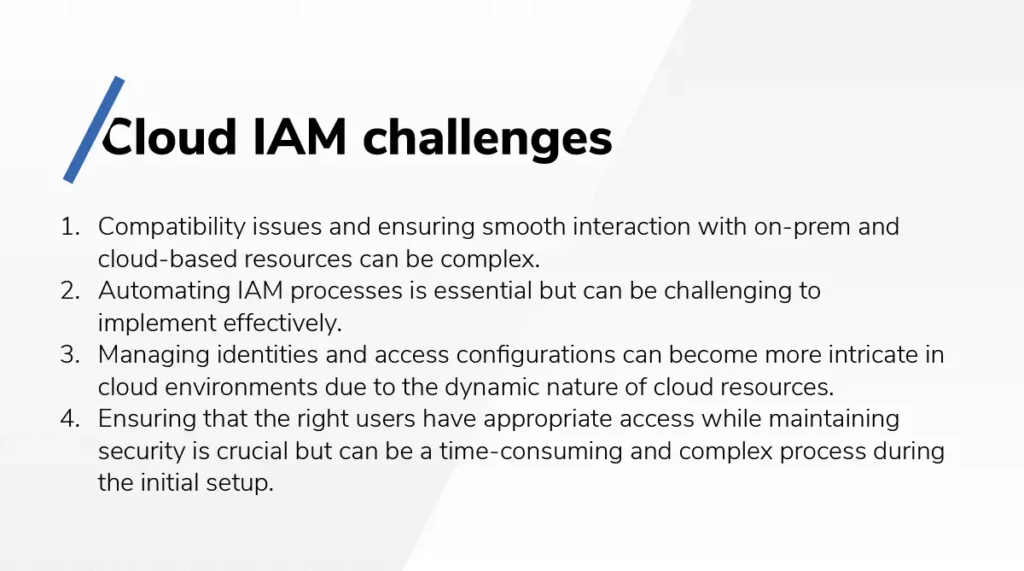
Cloud IAM challenges
Integration
One of the challenges in Cloud IAM is integrating it seamlessly with existing systems and applications. Compatibility issues and ensuring smooth interaction with on-premises and cloud-based resources can be complex.
Automation
Automating IAM processes is essential but can be challenging to implement effectively. This includes automated user provisioning and de-provisioning, access policy enforcement, and compliance checks, which require careful configuration and maintenance.
More complicated management of identities and configurations
Managing identities and access configurations can become more intricate in cloud environments due to the dynamic nature of cloud resources. Maintaining a clear view of who has access to what can be challenging without proper tools and strategies.
Initial task of configuring permissions when switching to Cloud IAM
Configuring permissions during the transition to Cloud IAM can be daunting. Ensuring that the right users have appropriate access while maintaining security is crucial but can be a time-consuming and complex process during the initial setup.
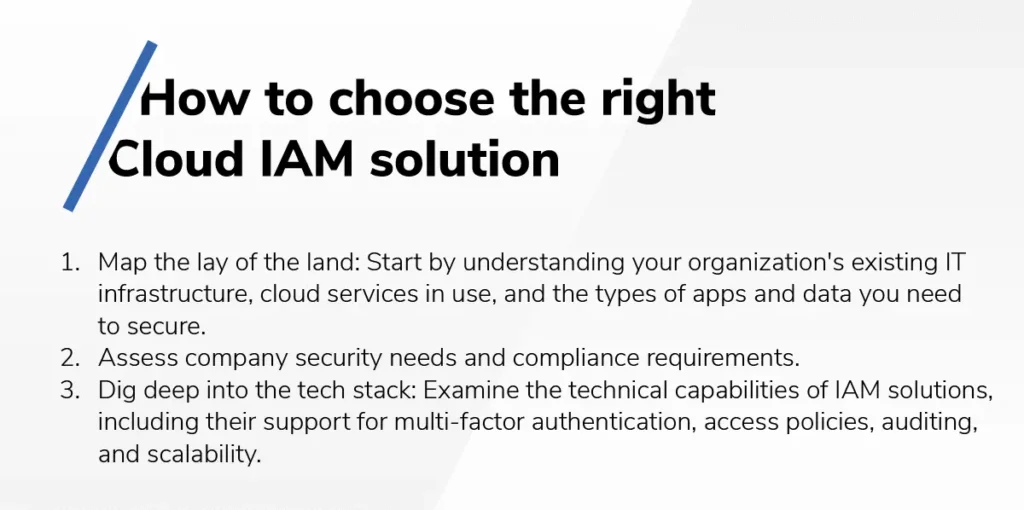
How to choose the right Cloud IAM solution
Choosing the right Cloud Identity and Access Management (IAM) solution is critical for securing your cloud environment effectively. Here’s a brief guide to help you make an informed decision:
Map the lay of the land
To choose the right Cloud IAM solution, start by understanding your organization’s existing IT infrastructure, cloud services in use, and the types of applications and data you need to secure. This assessment helps you identify the specific IAM requirements and integration points essential for your environment.

Assess company security needs
Evaluate your organization’s security needs and compliance requirements. Consider factors like the sensitivity of data, industry regulations, and the level of access control required. This assessment will guide you in selecting a Cloud IAM solution that aligns with your security objectives and provides a consistent access control interface.
Dig deep into the tech stack
Examine the technical capabilities of IAM solutions, including their support for multi-factor authentication, access policies, auditing, and scalability. Ensure that the chosen solution aligns with your existing technology stack and offers the flexibility to adapt to future changes and growth.
In conclusion, Cloud Identity and Access Management (IAM) is a crucial element of cloud security, offering various advantages and components to safeguard digital resources. However, it comes with its own set of challenges that require careful consideration. Choosing the right IAM solution involves assessing your organization’s needs, evaluating security requirements, and examining technical compatibility. By following best practices and staying vigilant, organizations can fortify their cloud security posture and benefit from the advantages that IAM solutions offer. Book a discovery call with our security experts today to set your custom IAM solution in motion.
FAQ:
Identity and access management in the context of cloud computing refers to the practice of securely controlling and managing user identities, their authentication, and permissions to access resources and services in cloud environments. It ensures that the right individuals have appropriate access to digital assets while maintaining security.
IAM and cloud identity are closely related but have distinct focuses. IAM typically covers broader identity and access management practices, while cloud identity specifically pertains to managing identities and access in cloud-based environments. Cloud identity is a subset of IAM, tailored for cloud services.
Cloud access management is a component of IAM that concentrates on controlling user access to cloud resources. It encompasses authentication, authorization, and policies that determine who can access what in cloud-based systems.
Cloud Identity and Access Management (IAM) is a comprehensive approach to securing digital assets in cloud environments. It ensures that user identities are managed effectively, access is controlled, and resources are protected. Its importance lies in safeguarding data, enhancing collaboration, and maintaining trust in the ever-evolving digital landscape.



